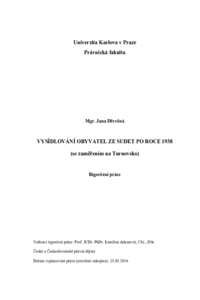Vysídlování obyvatel ze Sudet po roce 1938 (se zaměřením na Turnovsko)
Displacement of population from Sudetenland after 1938 (considering Turnov area)
rigorózní práce (OBHÁJENO)

Zobrazit/
Trvalý odkaz
http://hdl.handle.net/20.500.11956/90860Identifikátory
SIS: 174046
Kolekce
- Kvalifikační práce [13801]
Autor
Vedoucí práce
Oponent práce
Kuklík, Jan
Fakulta / součást
Právnická fakulta
Obor
Právo
Katedra / ústav / klinika
Katedra právních dějin
Datum obhajoby
12. 9. 2017
Nakladatel
Univerzita Karlova, Právnická fakultaJazyk
Čeština
Známka
Prospěl/a
Klíčová slova (česky)
Sudety, rok 1938, uprchlíciKlíčová slova (anglicky)
Sudetenland, year 1938, migrantsPráce řeší problematiku vysídlení obyvatel ze Sudet v roce 1938 z historicko-právního úhlu pohledu. Přes ustavení Československé republiky v roce 1938 a vymezení pojmu "Sudety" se zaměřuje na přesuny obyvatelstva po uzavření mnichovské dohody. Následně se věnuje oblasti Turnovska a městu Turnov, které se stalo v roce 1938 největším příhraničním městem na severu Čech. Od obecného dějinného průřezu se práce soustředí na sociálně právní změny v tzv. druhé republice a zároveň na aplikaci těchto norem v konkrétním regionu. Komparována jsou menšinová práva, život sudetských Němců v Československu a následně jejich život v tzv. Sudetengau a naopak menšinová práva Čechů v Německu v roce 1938. Zejména je řešena otázka přístupu vlády a obyvatel vůči uprchlíkům ze Sudet, kteří utíkali do vnitrozemí před nacistickým Německem. Jsou zmíněny tzv. uprchlické vlny a konkretizace skupin, které se ze Sudet stěhovaly. Změny v oblasti zaměstnanosti, podpory nezaměstnaných, bytové politiky a charitativní péče jsou vysvětleny z obecné roviny a jejich aplikace popsána na konkrétním příkladu města Turnov a jeho okolí.
The thesis discusses historical and legal aspects of the 1938 Sudeten populace displacement. It scopes over the establishment of the Czechoslovak Republic in 1938 to delimitation of the term "Sudeten" and focuses on populace movements in the Turnov area and the town of Turnov, which became the largest border town in the north Bohemia. After a brief historical overview, the focus is given to social and legal shifts in the so- called Second Republic and the application of these new norms in a specific geographic region. Minority rights and living conditions of Sudeten Germans in Czechoslovakia and later in Sudetengau are compared and contrasted with minority rights granted to Czechs in Germany after 1938. A particular attention is given to the attitudes of the government and locals towards the migrants from Sudeten fleeing from Nazi Germany. There is a description of refugee waves, concretization of groups that were leaving Sudeten regions. The changes in the areas of employment, unemployment support, housing policy and charity are exposed in general and their later application illustrated by the case of Turnov and its surroundings.
